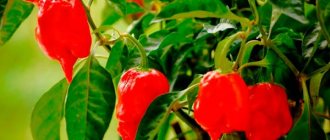Rare plants enjoy the same popularity and love among people as rosemary. Numerous varieties of this plant serve a variety of purposes. They are used to create hedges, green crops, potted arrangements and camouflage for unsightly walls. The refreshing resinous smell and slightly pungent taste of the leaves made it an indispensable culinary spice in ancient times.
Rosemary (Photo used under standard license ©ofazende.ru) 424
Parts used:
- leaves
- flowering shoot tips
The word rosmarinus means “sea dew”: in the wild this plant is found along the Mediterranean coast. Rosemary officinalis (R. officinalis) is the ancestor of all the countless varieties of forms and varieties of rosemary grown in gardens and vegetable gardens. Two other rosemary species (R. eriocalyx and R. tomentosus), native to southern Spain and northwest Africa, never became cultivated plants. Rosemary flowers can be colored in a variety of colors - blue, blue, purple, pink, white. The shape of the crown of this shrub also varies greatly - from spherical to columnar with a height of up to 3 m; in some varieties the shoots spread along the ground. Most varieties of rosemary are suitable for culinary use. All forms and varieties are evergreens with small, narrow, aromatic leaves.
Varieties
The best high varieties include:
Tuscan Blue
Variety with large leaves;
Tuscan Blue (Photo used under standard license ©ofazende.ru)
Portuguese Pink
A variety with an amazing aroma and pink flowers;
Portuguese Pink (Photo used under standard license ©ofazende.ru)
Among the varieties with the most intense blue flower color are Collingwood Ingram, Benenden Blue, Salem, Blue Lagoon, Severn Sea and Corsican Blue.
Related article:
The most beautiful hydrangeas for the Moscow region
Miss Jessup's Upright
The variety is distinguished by its tall growth and violet-blue flowers; “Suffolk Blue” has the same flowers.
Rosemary (Photo used under standard license ©ofazende.ru)
Gorizia
The unusually fragrant variety was introduced into cultivation by Tom Debaggio from the city of Gorizia in Northern Italy.
Varieties with pink flowers include 'Pink' and 'Provence Pink'; 'Wendy's White', 'Sissinghurst White' and 'Nancy Howard' have white flowers.
Forms with creeping shoots are ideal for wall decoration:
Lockwood de Forest
A variety with shiny leaves and blue flowers.
Lockwood de Forest
"Fota Blue", "Mason Finest" with very narrow and delicate foliage,
Prostratus
A variety with sky blue flowers.
Prostratus
'Santa Barbara' and 'Shimmering Stars' with pink buds and blue flowers.
Variegated varieties currently available include 'Genges Gold', 'Gilded' ('Aureus') and 'Silver Spires' with white-banded leaves.
The varieties “Severn Sea” and “Madeleine Hill” are superior to all other forms in cold resistance.
During World War II, rosemary leaves and juniper berries were burned in French hospitals to fight germs.
Every year on April 25, Australia and New Zealand celebrate Anzac Day. This national holiday is dedicated to the memory of Australians and New Zealanders who died in all wars and military conflicts. On this day, veterans attach sprigs of rosemary to their clothing: wild rosemary grew in abundance on Turkey's Gallipoli Peninsula, where more than 10,000 Australian and New Zealand soldiers died during the First World War.
Related article:
28 types of Lavender for your garden: Description and secrets of growing
Rosemary plant description
Rosemary is a perennial, evergreen plant belonging to the Lamiaceae family. This family also includes: sage, marjoram, thyme, oregano, basil, savory, lemon balm, mint and motherwort.
Close relatives of the spicy plant are such little-known representatives of the flora with “talking” names as: nutwing, bristletail, beautiful fruit, snakehead, catnip, ziziphora and odorous.
Rosemary is not an herb; it is a branched subshrub with blue flowers and small evergreen needle-like leaves.
The height of the plant can vary from 50 to 200 centimeters. The root system of the subshrub is very powerful and goes deep into the ground up to 4 meters.
The plant forms numerous branches. Old shoots harden over time, becoming olive-brown bark. And young ones remain green for a long period.
Rosemary leaves are narrow, leathery, grow densely and reach a length of 1.5-4 centimeters. They are slightly shiny above and slightly pubescent below. The leaves are linear in shape, thick, saturated with moisture, slightly curved at the edges and at the end. In general, they are very similar to spruce needles.
Rosemary has many positive properties. It is used not only as a spice for cooking and medicines, but also as an ornamental plant and landscape element.
The herbaceous minty aroma of rosemary will enchant anyone. Therefore, its oil is used in perfumery, pharmacology and phytocosmetology. Rosemary tastes slightly spicy and bitter. It is an indispensable ingredient in a mixture of Provencal herbs.
You can see what rosemary looks like in the photo below.
Useful properties of the plant
The leaves and tops of flowering shoots of the subshrub contain an essential oil that is part of medicinal preparations. Consisting of pinene, camphene, cineole, camphor and other substances, it is used for the manufacture of perfumes and alcoholic beverages.
An infusion of perennial leaves helps to cope with:
- headaches;
- colds;
- dysfunction of the gallbladder;
- cramps in the intestines;
- lack of milk in nursing mothers;
- neuralgic and rheumatic pains.
The herb is added to smoking mixtures to relieve asthma attacks. External use of leaf infusion is necessary to combat inflammation of the mouth and throat, boils, and acne. The solution is added to baths for neuritis and inflammation of the genital area in women and men.
See also
How to prepare rosemary for the winter: cover it, do you need to dig it up and prune itRead
In cosmetology, the herb is used to improve the condition of the skin and hair. It is effective for baldness.
As part of spicy compositions, the plant is necessary to flavor poultry dishes and sauces. Add the herb to tea.
Origin
The western part of the Mediterranean coast is considered the homeland of this unusual shrub. Rosemary is famous for its centuries-old history.
Historical facts
Translated from Latin, rosemary means “sea freshness”. The ancient Romans believed that the coastal sea wave gives the most delicate shade to flowers. This is where the name came from. People called this spice “incense herb”, “wedding flower” and “bride’s dress”.
- In ancient Greece, Egypt and Rome, rosemary was considered sacred.
- The ancient Greeks presented bouquets of rosemary as gifts to their goddess of love, Aphrodite. And in the Middle Ages, a bouquet of flowering plants was presented as a gift as a sign of prosperity and good luck. In some countries this tradition has been preserved to this day.
According to Christian legend: its white inflorescences acquired a delicate blue color when the Virgin Mary placed her cloak on the branches of the subshrub to hide little Jesus from the sun.
- The Egyptians placed blooming rosemary in the palms of the dead in order to brighten their path to the world of shadows with the aroma of freshness.
- The beauties of Hellas used this plant to care for their beautiful hair and delicate skin.
- The ancient Romans fumigated rooms with terminally ill people with rosemary and believed that the fresh smell warded off disease, death and evil.
- The Romans wove beautiful wreaths from plant branches and decorated themselves and their loved ones with them. It was the Romans who introduced Europe to this wonderful spice.
- The Hungarian Queen Erzsebet made a rejuvenating tonic from rosemary, which is why she was able to maintain her youth until she was 70 years old and seduce the Polish king.
- The flowers of the spice plant are a symbol of fidelity and eternal memory. They are often added to brides' wedding bouquets.
- In Turkey on the Gallipoli Peninsula, rosemary grew in large quantities and it was there that more than ten thousand Australian and New Zealand soldiers died during the First World War. Now in these countries on April 25, on the national holiday Anzac Day, those killed in military conflicts are remembered. On this day, veterans pin a branch of rosemary to their clothes.
- During World War II in France, hospitals burned rosemary leaves and juniper berries to protect against germs.
Composition, vitamins and microelements
Rosemary contains alkaloids (rosmaricin), ursolic and rosmarinic acids, and tannins. The leaves, flowers and upper parts of the shoots of the plant contain essential or rosemary oil.
| Parameter | Value (per 100 g of product) |
| Calorie content | 331 kcal |
| Fats (gr.) | 15,2 |
| Proteins (gr.) | 4,9 |
| Carbohydrates (gr.) | 64 |
| Water (gr.) | 9,4 |
| Dietary fiber (gr.) | 42,5 |
| Saturated fatty acids (gr.) | 7,4 |
| Vitamins | A, B1, B2, B6, B9, C, PP |
| Minerals (mg) | Calcium (1280), potassium (955), magnesium (220), phosphorus (70), sodium (50), iron (29.3). |
Contraindications for use:
- pregnancy;
- allergy;
- epilepsy
In cosmetology
Rosemary essential oil has many beneficial properties. If you comb your hair with this oil every day, it will become long and shiny. Essential oil stimulates hair follicles and is an excellent prevention of baldness; you can find many recipes with rosemary for hair treatment and restoration. It has no contraindications, except for individual intolerance.
In cosmetology, various masks and decoctions based on spices are used. For hair growth, you need to brew 4 tablespoons of the herb and leave it for about 4 days. The decoction must be rubbed into the scalp every 4 days. Hydrolate is produced from rosemary; this spray is used for cosmetic purposes, it refreshes and removes all inflammation on the face.
In folk medicine
Rosemary is also actively used in folk medicine:
- To get rid of gastrointestinal diseases, it is recommended to drink rosemary tea.
- The spice is also an excellent aphrodisiac and increases male potency. The dry mixture is sold in pharmacies, its average price is about 90 rubles.
Where does rosemary grow?
Rosemary grows uncultivated in Europe, North Africa, Greece, Spain, Portugal and Cyprus.
The wild subshrub is not found in Russia. Here it is grown as a cultivated plant. Gardeners plant it in pots, and on summer days they take it out into the open air and leave it in a well-lit place. In Russia, it is grown in Crimea.
Rosemary is also cultivated on a factory scale on rosemary plantations:
- The plant is rich in esters and is famous for its unique properties. To produce essential oil, the tops of young stems are cut off along with flowers and leaves during the flowering period.
- To use rosemary as a seasoning, young branches are collected before flowering throughout the summer. The collected shoots are dried in the shade under a roof or awning and then ground. Or supplied fresh. In the form of a dry seasoning, it can be stored for 2-3 years.
Growing rosemary at home
Landing
First of all, rosemary seedlings are grown from seeds; how to do this is described in detail above. After the height of the seedlings is 70–80 mm, they are planted in separate pots (it is better to take clay ones), which should reach 9–11 centimeters in diameter; there must be holes for drainage at the bottom. The container should be filled with a substrate that allows air and water to pass through well; to create it, a universal soil mixture is combined with vermiculite or sand. You can make a soil mixture from humus, sand, turf and deciduous soil (2:1:2:2). A small hole is made in the wet soil mixture, the depth of which should be equal to the height of the seedling root. Carefully remove the plant from the container, taking it along with the earthen lump, and plant it in a pot in a previously prepared hole. Lightly compact the substrate around the plant.
Illumination and temperature conditions
It is recommended to place the planted bush on a south-facing window. To ensure that the rosemary crown is beautiful and not one-sided, the container with the plant is regularly rotated 180 degrees around its axis once every 7 days. In spring and summer, it is recommended to move the bush, if possible, to fresh air (terrace, garden or balcony). With the onset of autumn, after the air temperature begins to drop to minus 1 degree, the plant is transferred into the house. It is not advisable to ventilate the room where the rosemary is located, since cold air from the window can harm it. However, if there is no air circulation in the room, then mold may appear on the bush. To avoid this, a fan should be running in the room every day for 3-4 hours. In winter, the air temperature in the room should be below 16 degrees, and the bush needs a low level of humidity at this time.
Pests
When grown indoors, aphids and arachnids can settle on the plant. If you notice pests on the bush, treat it with a solution of an acaricidal or insecticidal agent. Please remember that several treatments may be required to completely eradicate pests.
Watering
Make sure that the soil mixture in the pot with the plant is always slightly moist (not soggy). You can tell that a shrub is lacking moisture by looking at the lower foliage: it turns yellow. If there is too much moisture in the soil mixture, then the leaves of the bush begin to fly off.
It is recommended to moisten the substrate in a pot using a watering can with a long and narrow spout, because water should not get on the surface of the leaves, as this can cause mold. Before watering, the water should stand for at least a day, and its temperature should be close to room temperature.
Fertilizer
During the growing season from March to September, the plant needs to be fertilized with mineral fertilizers, which must include calcium. Feeding is carried out regularly twice a month. In winter, the plant is not fed at all or done much less frequently (once every 4–6 weeks).
Rosemary. Planting and care.
How rosemary blooms, features and life expectancy
The shrub blooms from April to July. In Israel, flowering can continue until November. The fruits ripen in September. The fruit resembles a nut: it is ovoid, smooth, and brown in color.
In summer, blue-violet inflorescences can be observed on the plant, which are slightly pubescent on the outside. The upper lip is notched, the lower is slightly longer than the upper.
Wild rosemary lives for 10-15 years, and at home it pleases the eye for 20-30 years.
It is unpretentious to the soil; it can grow even in rocky soil. But the bush does not tolerate excessive moisture in the ground. As a result, he dies or develops poorly. The structure of rosemary leaves helps it store moisture and thus withstand the summer heat.
And he certainly loves warm and arid climates, as he grows in open areas in the full sun. It does not tolerate cold weather, so its peak flowering occurs in the summer months.
Diseases and pests
If you are not careful, diseases may occur:
- white powdery mildew on the leaves of the stems - infection with powdery mildew (sharply cut off the damaged parts; replace the top layer of the substrate; spray with a fungicide or dip in a fungicide solution; then adjust watering and ventilation, put in a brighter place);
- brown leaves in winter - improper watering, mold, insufficient lighting (change the substrate, remove damaged parts, adjust watering, move to a brighter place).
Rosemary is a natural insecticide, so insects avoid it. However, it can sometimes be damaged by scabies mites and spiders. Industrial insecticides are used against them.
Types of rosemary
The subshrub has many varieties, but only 2 of them are the main types of rosemary and have a wide range of uses.
Common rosemary
It is the only species grown as a cultivated plant for culinary and pharmacological purposes. The species is distinguished by its unpretentiousness. It easily takes root both at home and in the garden.
Its foliage is lighter than other varieties. The inflorescences are closely adjacent to each other. Its flowers are of delicate shades: white, purple, pink and lilac.
Rosemary prostrate
Most often it can be found in southern latitudes. The bush has a spherical shape and reaches a height of 50-70 centimeters. Young leaves are thin, bright green. Old leaves are denser with a green-blue tint. In everyday life, it is mainly used for design and decorative purposes.
Possible cultivation options and care
How to grow rosemary outdoors or indoors depends largely on the climate of the region. There are four options for growing a plant: sowing seeds, cuttings, layering or dividing the main bush. The end of winter or the very beginning of spring is the best time to plant rosemary seeds for seedlings.
Varieties of rosemary
From rosemary (ordinary rosemary), breeders have been able to develop many different varieties. Rosemary varieties have slight differences in shape, leaf color, color palette, and area of application.
Corsican blue
Most often it is used for medical purposes. The leaves of this variety are grayish-green and have opposite leaf arrangement on the branch. The inflorescences grow in groups. They are small, blue, and have a bright aroma.
Blue winter
This variety is very popular among landscape designers. The shrub is adapted to frosty climates. The needle-shaped leaves are blue-green in color. Rosemary flowers are purple. It exudes a pleasant aroma of eucalyptus and pine needles.
Crimean
It has been growing on the Crimean peninsula since the 19th century. This variety is valued for its medicinal properties. It reaches a height of about one hundred centimeters. Does not tolerate temperature changes, is unpretentious to the soil and loves heat very much. Its leaves are dense blue-green. The flowers are white and purple.
Tenderness
This is one of the most popular varieties in Russia. He loves warm climates and bright sun. The height of the bush is about 90 centimeters. The leaves are usually green, but in September, when the fruit is formed, they darken and turn blue-green. They are thin, no more than 3 centimeters long. Flowers are blue.
Dewdrop
This variety of rosemary is widely used in cooking. Its leaves are dark green, very elongated, located tightly to each other, similar to spruce needles. They contain a large amount of essential oils that exude a mixed aroma of sea and lavender. The flowers are bluish-violet.
White
This variety is very rare. It is used for medicinal, culinary and decorative purposes. During flowering, the shoots reach 50-100 centimeters. Its leaves are bright green.
Ampelny
The variety is popular among landscape designers. It is thermophilic and rarely found in the wild, as the plant requires care. Its grown shoots twist and hang down bizarrely. It has bright green leaves and delicate purple flowers.
Preparing and sowing seeds
The rosemary sowing scheme consists of the following steps. First you need to put the seeds in warm water for 2-3 hours, as a result of which they will swell. Then sowing is done in pre-moistened sand to a depth of several millimeters.
The container with the sown seed material is covered with film and placed in a warm place; the ideal temperature for the early emergence of seedlings is 25 degrees.
Periodically it is necessary to moisten the soil surface to maintain the moisture required by the sprouts. To do this, it is advisable to use warm, settled water and a spray bottle. How to care for the plant after sowing will greatly affect its further development.
The first shoots will appear on the surface after 40-60 days and at this moment the covering film must be removed and the container moved to sunlight. Seedlings can be transplanted into open ground when they reach a height of 6-8 centimeters.
For those unfamiliar with rosemary
Rosemary is widely used in cooking:
- included in fruit salads;
- in the form of sauces and additives to the fillings of stuffed eggplants, tomatoes, zucchini;
- added to bean and pea dishes;
- included in dishes made from all types of cabbage;
- used in hot meat and poultry dishes;
- Lovers drink tea with the addition of rosemary.
Dear readers! A new magnificent plant may appear in your indoor flower garden, which will not only decorate the room, but also serve as a good healer. Try to grow it and you will not regret the time spent.
Rosemary in medical practice
Rosemary oil
Rosemary lotion
Medicinal dried rosemary
Rosemary leaves chemically contain 2.5% essential oils, 7% camphor, flavonoids, tannins (8%), alkaloids (0.5%), choline, betulin, verbenone, nicotinamide and a number of organic acids, including :
- ursol;
- glycolic;
- nicotine;
- coffee;
- caprylic;
- myristic;
- palmitic
- rosemary
A significant part of the listed acids have antifungal and antibacterial activity.
The beneficial components of rosemary include more than 9 vitamins and about 11 micro and macroelements.
Of particular value to doctors are essential oils, which contain:
- The camphor component is included in drugs that relieve muscle pain and muscle tension during intense sports training. Helps eliminate cramps. Used as a rub for rheumatism. A good choleretic agent.
- The cineol component is an integral part of many inhalation medications for catarrh. It has good antibacterial and antiseptic properties.
- Verbenone component - is included in antitussive drugs as an expectorant. It thins mucus well. Used for sluggish and insufficient digestion. Regenerates liver cells, has a positive effect on sexual problems. One of the best oils in cosmetology.
The beneficial and medicinal properties are countless. Rosemary is used in medicinal formulations to treat more than 80 diseases. The above properties of rosemary should influence your decision to supplement your indoor flower garden with this valuable plant.










